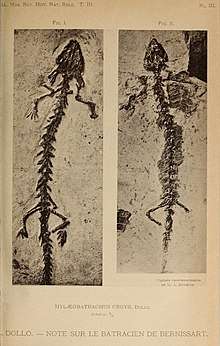Hylaeobatrachus
Hylaeobatrachus is an extinct genus of prehistoric salamander, known from the Early Cretaceous of Europe [1][2]. The type species H. croyii is known from the Iguanodon locality of Belgium, and was described by Louis Dollo. An indeterminate species is also known from Las Hoyas, Spain. Both localities are of Barremian age.
| Hylaeobatrachus | |
|---|---|
 | |
| Slab and counterslab of holotype specimen | |
| Scientific classification | |
| Kingdom: | Animalia |
| Phylum: | Chordata |
| Class: | Amphibia |
| Clade: | Caudata |
| Genus: | †Hylaeobatrachus Dollo, 1884 |
| Type species | |
| † Hylaeobatrachus croyii Dollo, 1884 | |
Description
It is around 10 cm long, the skull is pointed, with a distinct triangular profile. At least three ossified branchial arches were present. The front legs are distinctly shorter than the hind legs; the front limbs had four fingers, while the rear limbs have five.
gollark: Well, I did write *all* of them, by some definitions.
gollark: Did you accidentally use the GTech™ atemporal VPN?
gollark: Most won't so this would look bad.
gollark: Or use the "site themes" mode.
gollark: I see. I like this more. Troubling.
See also
- Prehistoric amphibian
- List of prehistoric amphibians
References
- "†Hylaeobatrachus Dollo 1884". Paleobiology Database. Fossilworks. Retrieved 12 April 2018.
- Martín, C.; Sanchiz, B. (2014). "Hylaeobatrachus Dollo, 1884". Lisanfos KMS. Version 1.2. Online reference accessible at www.lisanfos.mncn.csic.es/. Museo Nacional de Ciencias Naturales, MNCN-CSIC, Madrid (Spain). Archived from the original on 24 February 2014. Retrieved 21 February 2014.
This article is issued from Wikipedia. The text is licensed under Creative Commons - Attribution - Sharealike. Additional terms may apply for the media files.